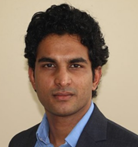Hybrid (In-Person or Virtual)
8A-8B Flexure Mechanism Design and Evaluation of Motion Constraints – Parts 1 and 2
Stuart T. Smith (University of North Carolina – Charlotte)
Kumar Arumugam (National Institute of Standards and Technology)
Marijn Nijenhuis (University of Twente)
Tuesday, October 11, 2022
8:00AM – 12:00N (PDT USA) – Part 1
1:30PM – 5:30PM (PDT USA) – Part 2
Flexure Mechanism Design and Evaluation of Motion Constraints (Part I&II)
Flexure-based stages and mechanisms are used in precision motion control and alignment applications including lithography, metrology instruments, mass balances, telescope mirror positioning, and medical devices. Flexure mechanisms offer frictionless, zero play, limited or zero hysteresis, and contaminant free motion in ranges of nanometers to millimeters and potentially 180° rotations. Their design needs consideration of numerous parameters such as volume, dynamics, lifetime, stresses in the flexural elements, range of travel, parasitic motion, rotation center shift, and load bearing capability. Therefore, the design process requires a vast range of design and analysis approaches to ensure its functionality.
Part I: Basics of flexure mechanism design, implementation, and mobility assessment
2/3rd of the tutorial covers:
Flexure joint and mechanism examples classified by their degrees of freedom
Manufacturing processes and assembly techniques
Parasitic errors in motion such as arcuate motion (foreshortening) and center shift
Types of actuators and their coupling to the mechanism, levers, lost motion, sensors, and damping techniques
Lagrangian – energy dynamics modeling
Damage assessment (number of cycles to failure)
Since flexure mechanisms made of leaf springs are widely used for their relatively larger range of travel, equations to determine their relative stiffness in different degrees of freedom, foreshortening, anticlastic curvature, elliptic integral to predict large deformation, and stiffness modification due to axial loading are studied.
1/3rd of the tutorial covers Mobility assessment
A fundamental step during the design process is to determine an optimal design with suitable constraints and freedoms. Mobility assessment using a simple Grübler’s equation helps to identify the undesired constraints that result in stresses during the motion of the mechanism. Once identified, overconstraints (sometimes good for load bearing) can be reduced by adding compliance at appropriate locations in the kinematic chain. Mobility assessment also helps to avoid undesired freedoms, thereby improving the dynamics and load bearing capability. The discussions cover the fundamentals and nuances in applying Grübler’s equation, case studies will be used to illustrate the utilization of this equation. As a lead-in to considerations of more complex 2D and 3D mechanisms, a quick review of conventionally used mechanisms, their mobility and their relative advantages and limitations will be provided.
Part II: Interactive web application for mobility visualization using flexible multibody analysis
Mobility analysis using the equation alone does not provide quantitative information about the consequences of the over and under constraints due to their directional dependence and complex geometries. To address the need to quantify these consequences, a multibody kinematic approach is used to visualize the free motions and constraining forces and moments in a given design, and this is discussed in Part II of the tutorial.
Part II initially focuses on a multibody formulation which uses kinematic equations for deriving a Jacobian matrix that relates coordinates and deformations. This helps to capture orientation dependent behavior of constraints in a mechanism. Later, the audience will be provided with an interactive web application for modeling and visualizing the mobility of flexure mechanisms. A brief introduction to a full multibody software which provides quantitative numbers indicating the effect of overconstraints on stresses and frequency modes will also be given. This can be helpful when considering design trade-offs between requirements such as stress of over-constraint competing against the stress of an off-axis load.
In summary, Part I gives an overview of basic flexure mechanisms and mobility assessment using Grübler’s equation to identify constraints and freedoms, and Part II introduces a web-based multibody software and the related theory to visualize the consequences of constraints in different mechanism designs.

Dr. Stuart Smith has been working in engineering since 1977 as a factory maintenance apprentice with Miles Redfern Ltd (UK). He is now a Professor of Mechanical Engineering in the Center for Precision Metrology at UNC Charlotte. Throughout the years his major focus has been the development of machines, instrumentation and sensor technologies primarily aimed towards the challenges of atomic scale discrimination and modifications. This work has resulted in the formation of four manufacturing companies, twenty patents, over a hundred journal publications, and the (co)authorship of five books.

Dr. Kumar Arumugam is currently a postdoctoral associate at the National Institute of Standards and Technology working on ‘small’ mass and force metrology. He received his doctoral degree at the Center for Precision Metrology, UNC Charlotte in 2021. His research interests include flexure mechanisms, frequency modulated interferometry, monochromatic confocal microscopy, and stylus profilometer characterization for surface metrology. Kumar has been involved in the ASPE community since 2017. He has given talks, presented research posters, and participated (later served as a committee member) in the student challenges conducted in the ASPE conferences.

Dr. Marijn Nijenhuis is an assistant professor at the chair of Precision Engineering of the University of Twente in the Netherlands. He holds a doctorate degree from the same university on the topic of the nonlinear analysis of flexure mechanisms. His research focuses on the analytical and numerical modeling of mechanical systems for the purpose of design and control. Research interests include flexible multibody dynamics and (electro)mechanical metamaterials.

